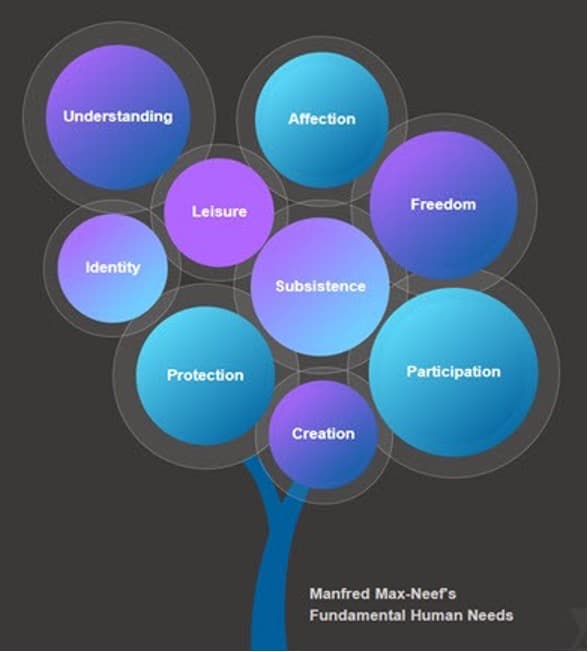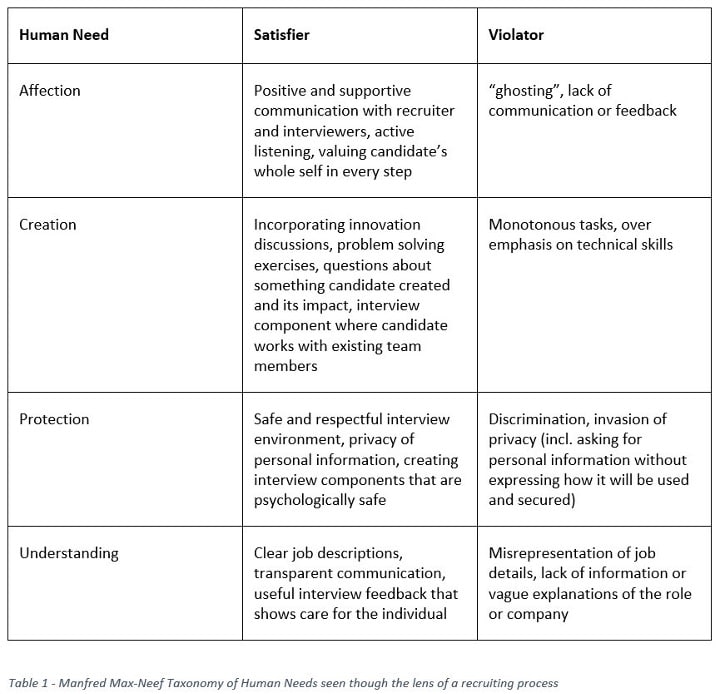The recruitment process isn’t just a series of interviews and evaluations; it’s a profound journey that can make or break a candidate’s perception of a company. And not only as a candidate but also as a customer, promoter, or detractor. The impact of a poor candidate experience can be huge: damage to the brand, diminished applicant volume, and decreased quantity and quality of the talent pool [1,2]. Surprisingly, a poor candidate experience can even have detrimental impacts on a company’s bottom line by negatively impacting and even shrinking its customer base [3]. Diving deeper into what constitutes the “candidate experience” reveals the fundamental human needs that are at its core.
Understanding the candidate experience
In talent acquisition, we commonly talk about “candidate experience.” Let’s define “experience” as “occasions that influence how a person sees the present and future differently than before.” Defined this way, candidate experience becomes a series of tangible and intangible moments in the candidate journey that influence how the person views and feels about your company going forward.
When a candidate has a negative experience with a company, it often means that their fundamental human needs were violated. Conversely, when human needs are met, candidates will have a good (or great) candidate experience. While those statements might sound blatantly obvious, the implications are critical.
Human needs in the recruitment process
In 1986, a Chilean Economist named Manfred Max-Neef published a taxonomy of human needs. He outlined nine fundamental human needs that are finite and universal across time. While the fundamental human needs remain consistent, the ways these needs are satisfied — what Max-Neef terms as ‘Satisfiers’ — vary based on time, geography, and circumstances. To illustrate, a Satisfier of the need for leisure for today’s American teenager might be video gaming. While adolescents in ancient Rome still had the need for leisure, it certainly wasn’t satisfied with an Xbox. Similarly, what exactly Satisfies a candidate’s need for Protection will be different for an unemployed job seeker versus a well-networked, currently employed senior executive.

When we think about candidate experience, we are really talking about the human experience. Consequently, when you notice underperforming hiring indicators, increased involuntary terms, or negative feedback on GlassDoor, you should assess your recruiting process with these human needs in mind. Where in the process are human needs being satisfied? Is there any place where those needs are being violated?
Consider a few examples in the table below. Some are prerequisites for a good recruiting process, while others will upgrade that process to the leading edge, helping you to build long-term relationships with candidates, even if they withdraw from the process or you turn them down.

The benefits of building long-term relationships are multifold – those former candidates will refer others, become customers, promote your brand, and reapply when better-fit roles come along. All of these benefits increase the network effect of your branding and recruitment efforts.
Actionable strategies for better recruitment outcomes
Where do you begin? First, if Max-Neef’s concepts are new to you, it’s worthwhile to delve deeper into his ideas. Once you’ve gained a clearer understanding, consider embracing an Assess-Strategize-Plan approach to effectively translate these insights into actionable strategies.
1. Capture your current state
Gather the existing process materials, including details of the interview components, messaging and branding, technology used, candidate personas, candidate feedback, and interviewer experience feedback.
2. Establish the desired future state and perform the gap analysis
Based on what was uncovered in the Assess phase, determine what needs to be changed, added, or removed. This will almost certainly include behavior changes on the part of process participants.
3. Plan and begin change management
People underlie all change, so bring people along. Conduct leadership workshops to align everyone on the vision and value. Estimate the level of effort, prioritize and sequence the work, and create the work plan.
Elevating the candidate experience by focusing on human needs will enhance your brand, lower your costs, boost your success in recruiting, and enable you to shift your recruiting process from a transaction to building meaningful relationships. This transformation is a crucial stride toward creating a self-sustaining cycle of attracting and retaining top talent for your organization.
1Burgess, Wade. “A Bad Reputation Costs a Company at Least 10% More Per Hire.” Harvard Business Review, 2016, https://hbr.org/2016/03/a-bad-reputation-costs-company-at-least-10-more-per-hire.
2Berendsen, Mark. “What’s the Business Impact of a Bad Candidate Experience.” Starred Blog, https://www.starred.com/blog/whats-the-business-impact-of-a-bad-candidate-experience.
3Hobbib, Bill. “Bad Candidate Experience: Why It’s Bad for Business.” Bullhorn Blog, https://www.bullhorn.com/blog/bad-candidate-bad-experience.
















